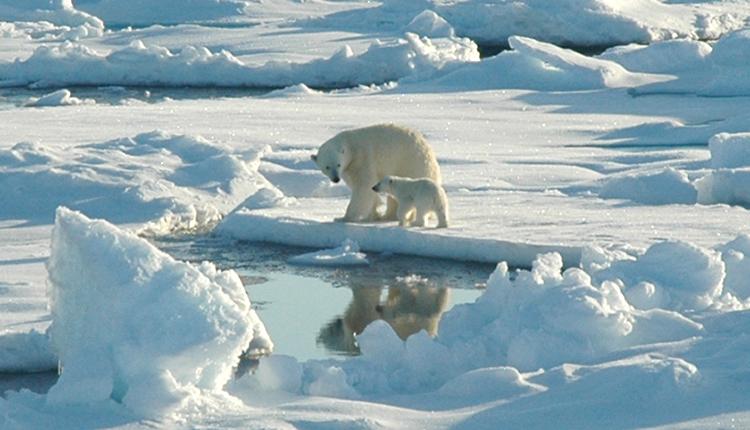Scientists are fighting against time to salvage the Last Ice Area, a frozen Noah's Ark in the Arctic
- EGBUCHUA DANIEL

- Nov 18, 2021
- 4 min read
Polar bear DNA was discovered in 2012, revealing that the iconic animal had previously faced extinction, very likely during a warm time 130,000 years ago, but had recovered. The finding sparked one pressing problem for scientists: Could polar bears make a comeback?
Studies like this one have bolstered an ambitious project to establish a reserve in the Arctic enabling ice-dependent species, from polar bears to microorganisms, to lay down and wait out climate change. Conservationists are relying on an area in the Arctic known as the Last Ice Area, where ice that lasts all through the summer could endure the longest in a warming planet.
The Arctic will make its last stand here. But it's unknown how long the Last Ice Area will be able to keep its summer sea ice. According to a computer simulation produced in September, the Last Ice Area might keep its summer sea ice eternally if carbon emissions do not raise global temperatures by more than 2 degrees Celsius over preindustrial levels, as stated by the 2015 Paris Climate Agreement (SN: 12/12/15). However, a recent UN report found that existing commitments to decrease emissions will warm the climate by 2.7 degrees Celsius by 2100, putting the Arctic's summer sea ice at peril (SN: 10/26/21).
Ecosystem of the frozen sea
The Last Ice Area is a large floating icescape that stretches from Greenland's northern coast to Canada's Banks Island in the west. Because of an archipelago of islands off the coast of Canada that prevents sea ice from moving south and melting in the Atlantic, this region, nearly the length of the West Coast of the United States, has the oldest and thickest ice in the Arctic.
The muddy belly of the icebergs is home to plankton and single-celled algae that have evolved to grow directly on the ice. These species form the backbone of an ecosystem that eats everything from tiny crustaceans to scarab beetles, ringed seals and polar bears. These plankton and algae cannot survive without ice. As summer ice disappears in the Arctic, the foundation of this ecosystem is literally melting. “Much of the habitat on which species living in the Arctic depend will become uninhabitable,” said Brandon Laforest, an arctic expert at World Wildlife Fund Canada in Montreal. “There is nowhere to go for these species. They are actually stuck in the last ice area.
As ice from other parts of the Arctic collides with this natural barrier, it stacks up, generating huge, towering ice ridges that stretch for kilometers over the frozen tundra. The region seems barren from above.Polar bear DNA was discovered in 2012, revealing that the iconic animal had previously faced extinction, very likely during a warm time 130,000 years ago, but had recovered. The finding sparked one pressing problem for scientists: Could polar bears make a comeback?
Studies like this one have bolstered an ambitious project to establish a reserve in the Arctic enabling ice-dependent species, from polar bears to microorganisms, to lay down and wait out climate change. Conservationists are relying on an area in the Arctic known as the Last Ice Area, where ice that lasts all through the summer could endure the longest in a warming planet.
The Arctic will make its last stand here. But it's unknown how long the Last Ice Area will be able to keep its summer sea ice. According to a computer simulation produced in September, the Last Ice Area might keep its summer sea ice eternally if carbon emissions do not raise global temperatures by more than 2 degrees Celsius over preindustrial levels, as stated by the 2015 Paris Climate Agreement (SN: 12/12/15). However, a recent UN report found that existing commitments to decrease emissions will warm the climate by 2.7 degrees Celsius by 2100, putting the Arctic's summer sea ice at peril (SN: 10/26/21).
Nonetheless, other experts believe that if humanity banded together to limit emissions and install tech to absorb carbon and other greenhouse gases, the consequences of climate change on sea ice may be minimized, if not reversed. However, the Last Ice Area might buy ice-dependent species time in the struggle against extinction by serving as a refuge where they can endure climatic change and possibly make a comeback in the future.
Ecosystem of the frozen sea
The Last Ice Area is a large floating icescape that stretches from Greenland's northern coast to Canada's Banks Island in the west. Because of an archipelago of islands off the coast of Canada that prevents sea ice from moving south and melting in the Atlantic, this region, nearly the length of the West Coast of the United States, has the oldest and thickest ice in the Arctic.
The muddy belly of the icebergs is home to plankton and single-celled algae that have evolved to grow directly on the ice. These species form the backbone of an ecosystem that eats everything from tiny crustaceans to scarab beetles, ringed seals and polar bears. These plankton and algae cannot survive without ice. As summer ice disappears in the Arctic, the foundation of this ecosystem is literally melting. “Much of the habitat on which species living in the Arctic depend will become uninhabitable,” said Brandon Laforest, an arctic expert at World Wildlife Fund Canada in Montreal. “There is nowhere to go for these species. They are actually stuck in the last ice area.
As ice from other parts of the Arctic collides with this natural barrier, it stacks up, generating huge, towering ice ridges that stretch for kilometers over the frozen tundra. The region seems barren from above. This is a short trailer from the national geographical channel taking us to the last ice






Very insightful....good to know
Nice writeup....can't wait for the shoe on Nat geo